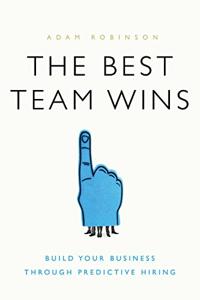
Want to learn the ideas in The Best Team Wins better than ever? Read the world’s #1 book summary of The Best Team Wins by Adam Robinson here.
Read a brief 1-Page Summary or watch video summaries curated by our expert team. Note: this book guide is not affiliated with or endorsed by the publisher or author, and we always encourage you to purchase and read the full book.
Video Summaries of The Best Team Wins
We’ve scoured the Internet for the very best videos on The Best Team Wins, from high-quality videos summaries to interviews or commentary by Adam Robinson.
1-Page Summary of The Best Team Wins
Most companies perform poorly at hiring new employees and at training managers in how to recruit and hire. You can improve your hiring.
Robinson states that the biggest challenge companies face is securing the right employees. Hiring demands risk management, but most companies fail at this task. Most firms don’t have a formal hiring process, even though employees are usually around 70% of total expenses. Your workforce is both your greatest cost and competitive edge.
Most companies have ineffective strategies for how to recruit and hire. Managers fail at hiring because their companies don’t teach them how. “The skill that will separate mediocre managers from exceptional ones,” the author writes, “is finding great people and retaining them.”
Improve your recruiting and hiring with a four-stage system:
Robinson presents a four-step process for hiring the right employees and building great teams. He argues that this system will help managers find, recruit, and hire top performers at lower costs than other methods. The four steps are:
Stage One: “Define the role.” Spend a day each week recruiting and hiring, and develop a comprehensive job profile for each open position.
Robinson warns that your rivals can probably compete with you in price, technology, products and services. But they cannot beat you on one thing: your employees. Having the best employees is an advantage over your competitors because it helps create a positive culture which prevents people from leaving and gives them more time to focus on their work rather than recruiting new ones.
Robinson cites a survey from The Conference Board that shows the most important issue for CEOs is retaining and acquiring quality human capital. It’s more important than maintaining strong customer relationships or efficient operations.
Robinson argues that managers can take control of recruitment and hiring. First, carefully define the job you want to fill. The author suggests creating a full job profile that describes exactly what the open position entails, its responsibilities and its requirements for production – in other words, what your firm expects from someone filling this role. Allow enough time for recruitment: 20% of your week should be devoted to recruiting and hiring new people.
Robinson provides a five-step process for hiring new employees: 1. Find candidates by using the right tools, including technology and networking. Contact promising prospects by phone or email.
Initial Interviews – Managers can eliminate 75% of applicants during telephone interviews. In-Person Interviews – Face-to-face meetings should include several people from your company. Half of your job candidates will sort out during this step.
“Assessments, references and background checks” – Check candidates’ skills and job-fit assessments. Speak with their previous managers to determine how they performed in their previous jobs. This should help you decide on one person to hire. 5. “Make an offer”– Present the top candidate with an offer package that includes a salary and other compensation as well as benefits such as health insurance, paid vacation time off, or retirement plans for example. Robinson admits that making this decision is a huge financial risk because if you make the wrong choice it will cost your firm a great deal of money; however, if you make the right decision it will help your company succeed.”
Robinson urges you to ignore your gut feeling about a potential candidate. Your gut may be right – or it may be wildly, disastrously wrong. Look past the job candidate’s résumé and look at four elements: attitude, personal accountability, previous strong work success and cultural fit. Gut decisions carry with them risk of substantial bias when it comes to hiring and screening candidates.






